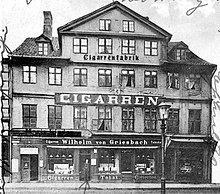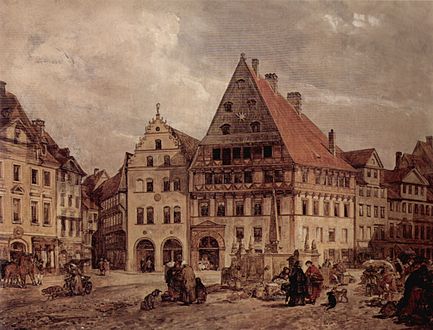House Leuenturm
The house Leuenturm , Hutfiltern 2 ( insurance number 193/4), also called Lauenthurm , is a plastered half-timbered house from 1777 in Braunschweig , which has been under monument protection since 1964 . It stands in the soft picture of the old town at the northeastern transition from Kohlmarkt to Hutfiltertern street .
history
Before today's three-storey, eaves-facing residential and commercial building with a saddle roof and central gable was built in 1777, there was a building there that was demolished in 1639. Before that, the Ulrichs or Löwentor , mentioned in 1292, stood in the same place , which in the Middle Ages formed the eastern boundary between the two soft areas of Altstadt and Altewiek .
The history of the Leuenturm is linked to the inner-city unrest of 1292/93 during the time of Heinrich the Wonderful , the so-called Gildemeister shift . During this shift , twelve Gildemeisters broke away from the old town council, moved into the tower and temporarily made it their new town hall .
The heraldic animal and symbol of Brunswick has been the Brunswick lion since the 12th century , which Duke Heinrich the Lion had built around 1166 on the castle square in front of Dankwarderode Castle and Brunswick Cathedral . The legend that the Council should the city have decided around 1400, one living in the tower lion to keep. Then an animal was bought in Italy and brought to the city. The tower was named Leuenturm after the Low German word Leu or in Brunswick dialect Lau (w) e for lion . In the interest book of 1402, "dat lowendor" is mentioned for the first time, which has retained its name in a modified form to the present day.
When the tower became dilapidated, it was torn down and a new one was built between 1545 and 1550. This new lion tower was set up, among other things, as a prison for ... unwanted bourgeois sons and 'naughty people' ... until it was also torn down in 1639. The half-timbered house, built in 1777, was rebuilt several times in the 19th century on the ground floor to provide space for shops, so around 1880 the Leuenthurm café was located there .
Until around the time of the Second World War , a coat of arms with the city arms of Braunschweig , the Braunschweig lion, was attached in the middle of the outer wall of the second floor. The house survived the numerous bomb attacks on the city largely undamaged. Shortly after the end of the war (already visible in photos from 1950) this coat of arms was replaced by a lion looking to the left from the observer and standing in front of an old castle or defense tower . Above and next to it there has also been the inscription Haus Leuen Turm since then .
Urban environment
The northeastern part of the Kohlmarkt , painted by Ludwig Tacke in 1894 .
Photography around 1905: In the center the new fountain by Oskar Sommer . The Leuenturm house is on the far right.
literature
- Ferdinand Spehr : Patriotic stories and memorabilia of the prehistoric times of Braunschweig and Hanover. by Wilhelm Görges , 2nd edition, completely revised and enlarged by Ferdinand Spehr. Third (popular) edition. First part: Braunschweig. Friedrich Wagner's Hofbuchhandlung, Braunschweig 1885, p. 25.
- Jürgen Hodemacher : hat filters. In: Braunschweig's streets - their names and their stories. Volume 1: Inner City. Elm-Verlag, Cremlingen 1995, ISBN 3-927060-11-9 , pp. 160-161.
- Wolfgang Kimpflinger: Monuments in Lower Saxony. Volume 1.1 .: City of Braunschweig. Part 1. (= monument topography Federal Republic of Germany . ) Hameln 1993, ISBN 3-87585-252-4 .
- City of Braunschweig, Bauverwaltung (Hrsg.): Investigation into the building history of the Kohlmarkt. (= Urban design in Braunschweig. ) Braunschweig 1980 OCLC 256207412 .
Web links
Individual evidence
- ↑ a b c d Ferdinand Spehr: Patriotic stories and memorabilia of the prehistoric times of Braunschweig and Hanover. urn : nbn: de: gbv: 084-21067 p. 25 ( dfg-viewer.de ).
- ↑ a b c City of Braunschweig, Bauverwaltung (Ed.): Investigation of the building history of the Kohlmarkt. P. 28.
- ↑ Oscar Döring: Famous Art Places No. 31 Braunschweig. Verlag von EA Seemann, Leipzig 1905, urn : nbn: de: gbv: 084-20642 p. 17 ( dfg-viewer.de ).
- ↑ a b Wolfgang Kimpflinger: monuments in Lower Saxony. Volume 1.1 .: City of Braunschweig. Part 1. p. 95.
- ↑ Jürgen Hodemacher: hat filters. In: Braunschweig's streets - their names and their stories. Volume 1: Inner City. P. 160.
Remarks
- ↑ For Beck , it is either Johann Georg Beck or his son Anton August Beck , both as an engraver working in Braunschweig.
- ↑ However, the market before 1868 is shown, as the old Kohlmarktbrunnen (new building 1868/69) and the old house at the golden star , which was only replaced by a new building in 1904, can still be seen. In clockwise direction are shown: Haus zur Sonne , the confluence with Schuhstrasse , Haus zur Rose , Haus zum (golden) Stern and Haus Leuenturm on the far right of the picture.
Coordinates: 52 ° 15 ′ 45.1 ″ N , 10 ° 31 ′ 14.8 ″ E





